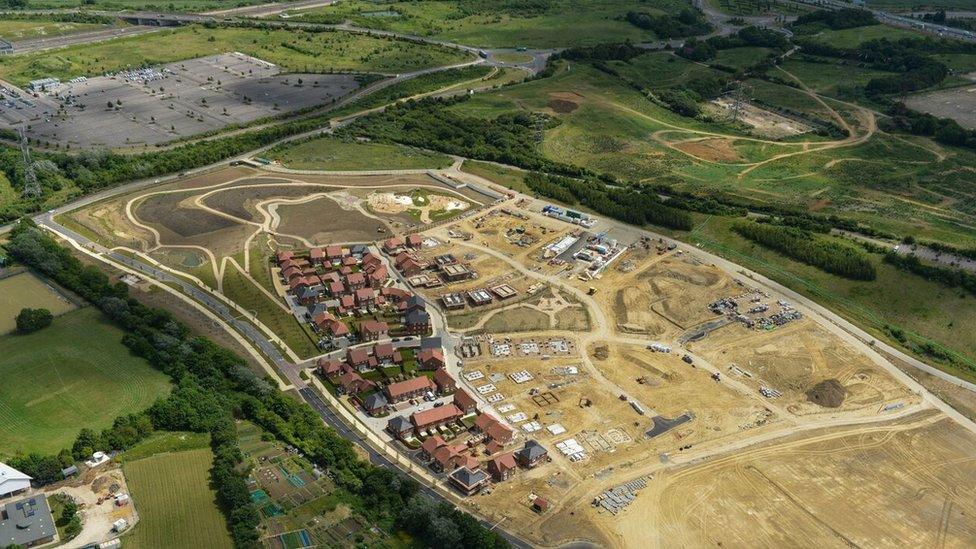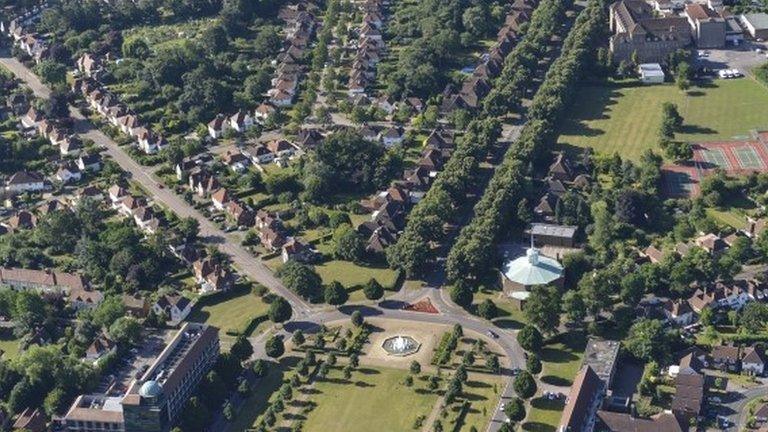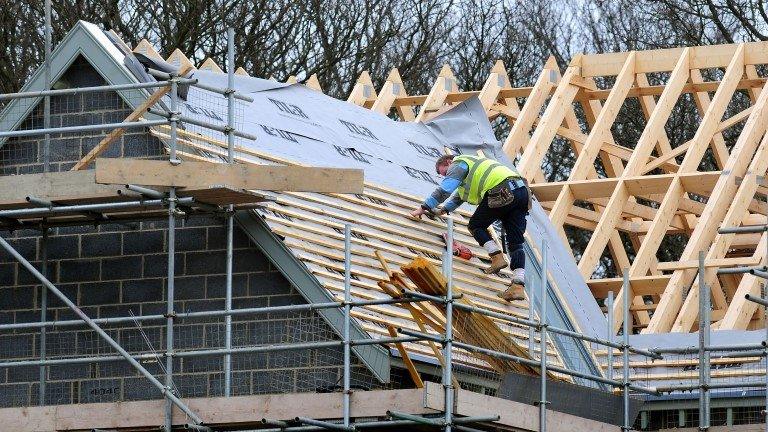Ebbsfleet: Model garden city?
- Published

Ebbsfleet, in Kent, would appear to be an ideal development opportunity, as estate agents put it.
In the Thames Estuary, it's just 17 minutes from central London via high-speed rail, the giant Bluewater shopping centre is a short drive away and there's planning permission for 15,000 new homes in a lovely landscaped setting.
And yet, eight years after construction started, there are only 350 housing units on this giant empty site, which was once four quarries.
That's partly down to the recession and partly down to the way property developers work.
In a revealing article, external published last year, Francis Salway, former chief executive of the largest listed property company in the UK, Land Securities, explained that developers don't relish huge empty sites like the former quarries at Ebbsfleet.
They like "established demand" and "existing communities", he wrote, which prove people really do want to live there. The developers like to "limit the forthcoming supply" - that is, to ration how many homes come on to the market at one time so that the market is not flooded.
They don't like long projects which risk being hit by a downturn and they don't like high "up front" costs - cleaning up sites and building new roads and sewage plants.
Phase by phase
Last year, Barratt Homes began building a new "village" called Castle Hill - phase one is 150 homes. They will soon announce a second phase of 266 units.

Sales manager Natalie Perry says phase one of Castle Hill has sold out
That exemplifies Mr Salway's points - testing the market, building phase by phase.
Natalie Perry, sales manager at Castle Hill, showed me round one of the gleaming, detached show houses.
Traditional on the outside, the "Cadleigh" has modern, flexible living space, a smart fitted kitchen with shiny ceramic flooring, a garage, a study and four bedrooms. The price would be £599,000 - if there were any left to sell.
Purchasers - many benefiting from the government's Help to Buy scheme - are happy to be pioneers here and pay more than they would in the established nearby town of Swanscombe. Phase one of Castle Hill has sold out.

One of these homes would cost you almost £600,000
Other housebuilders are moving in, but the pace of construction is slow and the housing shortage in the South East of England is acute.
Last year, the government announced Ebbsfleet would be the site of the first garden city for a generation.
It set up a development corporation - in many ways similar to those of the garden cities of the distant past, like Letchworth, or the post-war new towns like Stevenage or Milton Keynes.

Garden cities
The garden city planning concept, by Sir Ebenezer Howard, was first used to create Letchworth Garden City at the start of the 20th Century and Welwyn Garden City in the 1920s.
They were called garden cities because their layouts included large amounts of green space.
The concept was adopted again after World War Two when the New Towns Act resulted in the development of new communities to deal with an accommodation shortage caused by bomb damage, stagnation in the construction industry, returning service personnel and a baby boom.
Twenty-seven new towns were built across the UK, including Stevenage, Harlow, Milton Keynes, Corby, Cwmbran, Newton Aycliffe, Peterlee and Cumbernauld.
Two years ago the government commissioned a report on the possibility of using garden cities to help deal with the housing shortage.
Last year the government announced plans to build three garden cities. Ebbsfleet in Kent was named as the first modern garden city and Bicester in Oxfordshire was chosen as the second. The third is yet to be named.

The corporation has planning powers over the whole site: it has government funding, initially of £200m, to pay for major infrastructure and its job is to get the garden city built as fast as possible.
There is a key difference between this new corporation and the traditional models though: the land is in private hands - owned or controlled by Land Securities - rather than owned by the corporation itself.

Phase two of Castle Hill will soon be announced
Missed opportunity?
Michael Cassidy, the new chair of Ebbsfleet Development Corporation, was responsible for the building renaissance of the City of London. He has a formidable reputation.
He told me more houses would soon be going up at Ebbsfleet - his aim was to build more than 1,000 homes a year, by working closely with developers and making it "worth their while".
He agreed many industry experts had advised the corporation would do better to own the land itself but said he was happy to work with the model he had.
A spokesman for the Department for Communities and Local Government said: "Ebbsfleet residents are at the heart of our efforts to build the first garden city for over a century, delivering thousands of new homes, as well as new commercial premises and community facilities. We considered land acquisition, but in this case concluded holding land was not the most efficient use of public sector funds."
The government sees Ebbsfleet as the model for delivering much-needed housing in other parts of the country.
But many worry it could be an opportunity lost. New towns of the past, owning their own land, could deliver housing quickly.
They also made a profit over time, as land values rose. They paid back their original loans early and even today there is still £335m worth of new town land on the government books.
Listen to Sanchia Berg's report from Ebbsfleet on Today on Radio 4 on Tuesday, 3 November.
- Published10 July 2015

- Published3 March 2015

- Published2 December 2014

- Published4 September 2014

- Published14 April 2014

- Published16 March 2014
